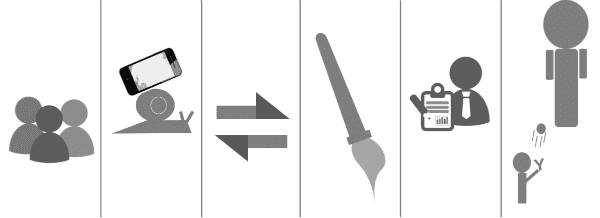6 digital workplace trends from recent Intranet Innovation Awards

The annual Intranet Innovation Awards show how intranets and digital workplaces are evolving. This post gives six observations on themes such as mobility, social tools and the value of integrating systems. It also includes information on how to enter the 2015 Awards.
The Intranet Innovation Awards
In my line of work, I’m lucky enough to be able to work for two of the leading global organizations in the intranet and digital workplace field. For the past four years I’ve combined my work for DWG with my role of co-ordinating the annual Intranet Innovation Awards.
The Intranet Innovation Awards, run by Step Two Designs based in Australia, celebrate new and innovative designs, approaches and features of intranets and other related digital channels. Past winners have included Barclays, PwC and Johnson & Johnson, all of whom either are or have been DWG members. Winning intranets have also regularly featured on DW Live.
Apart from being great fun, the Awards also mean I get to see many examples of very interesting intranets and enterprise social networks (ESNs) each year. Looking at so many different examples gives a broad sense of how intranets and digital workplaces are evolving. Here are six megatrends I’ve observed through my involvement with the competition.
1: Social has become normalized
Probably peaking in 2012, we received many entries that focused on integrating social tools and features. For many organizations, giving all employees a voice was certainly radical and innovative. However, by 2014, hardly any entries featured integrated social tools as the main element of the entry. Social was now mentioned in a much more matter-of-fact way. It was clear that social had become largely normalized and was no longer considered particularly innovative.
2: Mobile progress has been slower than we expected
Most digital workplace professionals observe that progress on the mobile intranet front has generally been slow in organizations. The recent Awards have done little to change this view, with fewer entries centring around mobile than we had expected. Having said that, we have found that an increasing number of new intranets are using responsive design, so are optimized from day one.
3: Integration really adds value
It may have been coincidence, but in the last two years we’ve had an increase in the number of entries that have integrated systems into the intranet to add value for users. We’ve seen this particularly in relation to HR processes, project management tools and also in intranets interfacing with CRM and financial systems.
The value comes either from giving the user access to all the systems they need in one place, which is in turn wrapped up in a consistent and good user experience, or by drawing on data from different and disparate systems and bringing them together in ways that add value.
4: Intranet design has ramped up
Overall, intranet design has improved. This steady improvement has been evident throughout the four years of entries, to the point that there are hardly ever any really badly designed intranets any more.
Of course, some could be better and there are almost always some usability issues to address, but overall the best intranets look great and are easily up there with consumer websites. I think part of the reason for this is that there has been much more emphasis on the use of images. The days of internal channels being the poor cousin to the corporate website – at least in terms of design – are hopefully coming to an end.
5: The best teams do their homework
Some of the most powerful solutions are clearly the product of really thorough research, testing and observation. You have a real head start in designing your digital channel if you know your users inside out: what they need, how they behave and their pain points.
I can think of various examples, such as Mayo Clinic’s amazingly detailed research into the information needs of busy nurses, enabling an intranet that helps support patient care; and last year the team at Telstra observed that users wouldn’t use a personalized HR dashboard with sensitive information in an open-plan office, so they simply greyed out the pay data by default.
6: Any organization has the potential to produce a great digital workplace
Each year we’re always surprised by the range of organizations that enter, but I certainly never expected that last year’s overall platinum winner would be a Florida high school!
Lakewood High School has a rich SharePoint 2013 environment with mobile access, custom apps and much more that would be the envy of some organizations. However, the fact that this was all built and maintained by the students is perhaps the most inspiring aspect. It just shows that any organization has the potential to produce a great digital workplace.
Over to you!
Of course, I’m excited about seeing this year’s crop of entries and eventual winners. The Intranet Innovation Awards have just opened for submissions and will accept entries up until June 5th.
There are five categories for entries:
- Core intranet functionality
- Social, collaboration and communication
- Business and frontline
- Enterprise mobility
- Intranet rework
So, if you’ve done something new and interesting that has had real impact, then please do consider entering.
Your entry could be an intranet, an ESN, an HR portal or a digital workplace. It’s completely free to enter, there are no hidden costs at all and you could be the winner of a lovely trophy. Good luck!
Categorised in: → Intranet usability, Digital workplace trends, Intranets
